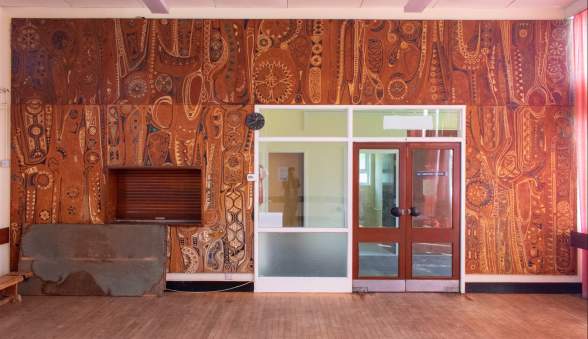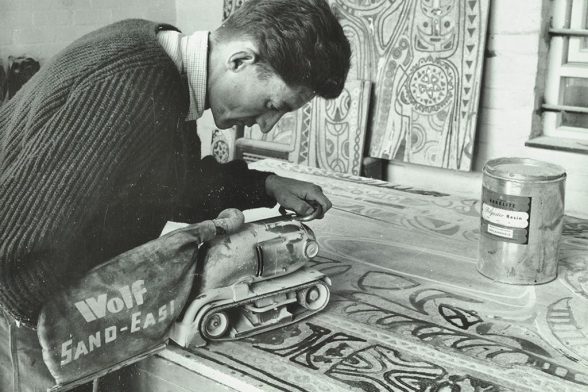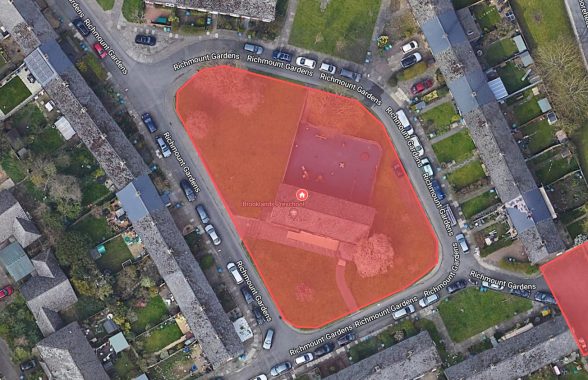This website uses cookies
This website uses cookies to enable it to function properly and to analyse how the website is used. Please click 'Close' to accept and continue using the website.



Image credit: Historic England
C20 Society has backed a local campaign to save an early William Mitchell mural and community clubhouse on the Brooklands Park Estate in Blackheath, currently threatened with demolition and redevelopment for housing.
Designed in 1958, the large decorative panels (20ft x 12ft) that make up the mural are made from routed plasterboard, inlaid with Bakelite – a pigmented polyester resin. The organic design of the mural is in keeping with the brief of LCC architect Rosemary Stjernstedt, that the housing on the Estate integrated with the outside areas, but did not dominate the landscape. Mitchell-expert Dr. Dawn Pereira believes it to be one of the best-preserved of the artists’ early works still surviving in situ.
Richmount Gardens is located on the Brooklands Park Estate in the south of the Cator Estate, within the boundaries of the Blackheath Park Conservation Area. Brooklands Park was built by the London County Council and completed in 1958. It combines 2-storey houses with 5- and 6-storey blocks of flats, thoughtfully laid out on a site formerly owned by the Cator family. The modest, single storey building containing the mural was the estate’s clubroom, and has more recently operated as a children’s playgroup. An article titled ‘Art Collaboration’ in the Architects’ Journal (9 April 1959) discusses the LCC’s exciting new collaboration with “two young graduates of the Royal College of Art”, Anthony Hollaway and William Mitchell, “in the development of new techniques of decorative treatment on or in flats and other buildings on housing sites” . It includes an illustration of Mitchell at work on the Brooklands Park mural, cutting the pattern into plasterboard to be filled with coloured polyester and polished.

Image credit: London Metropolitan Archives (City of London Corporation)
Following a tip-off from the Blackheath Park Conservation Group on the development proposals, C20 applied to have both the clubhouse and mural listed in December 2022. This was rejected by Historic England in October 2023, on the highly questionable grounds that the mural “is not eligible to be recommended for listing…because it is neither a fixture of the Community Centre nor a building in its own right”.
The Society has since been in consultation with Greenwich Council regarding their plans for the site. As part of the proposals for 6 new residential dwellings, the existing mural would be relocated locally and made accessible to the public, via a pre-commencement condition on the planning application. We have maintained our objections to the plans as submitted, advocating for both the mural and clubroom to be preserved and enjoyed together, as originally intended. We believe that new housing could be accommodated elsewhere on the wider Cator estate, without the need to demolish a valued community asset and uproot a site-specific artwork.
Relocation of historically significant murals is possible, but the success of the outcomes can vary enormously. For example, the Grade II listed Dorothy Annan telecommunication murals were expertly and sensitively relocated from a building on Farringdon Road to the Barbican in 2012. However the Grade II listed Lee Valley Water Company Mural, also by William Mitchell, was rather incongruously relocated to the wall of a new housing estate in 2013.
Mitchell and Murals Campaign
William Mitchell (1925-2020) was one of the most important sculptors active in England in the post-war period. The Society has long been interested in Mitchell, and several of his works have been saved thanks to our ongoing Murals Campaign, launched in 2009.
Wider appreciation for Mitchell’s work continues to grow and 15 of his artworks are now listed on the national register – 3 at Grade II* (Harrods in Knightsbridge, Roman Catholic Cathedral in Liverpool, and Clifton Cathedral in Bristol). Recent listings include the murals in the Hockley Flyover in Birmingham and ‘Scenes of Contemporary Life’ in the Park Place underpass in Stevenage, which were both designated Grade II in 2022.

Image credit: Royal Borough of Greenwich

Become a C20 member today and help save our modern design heritage.